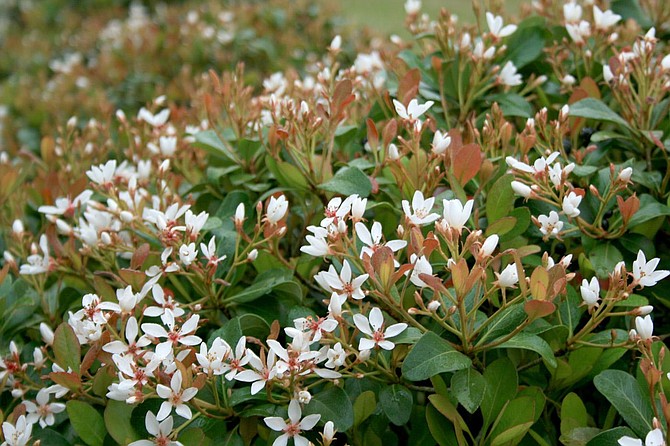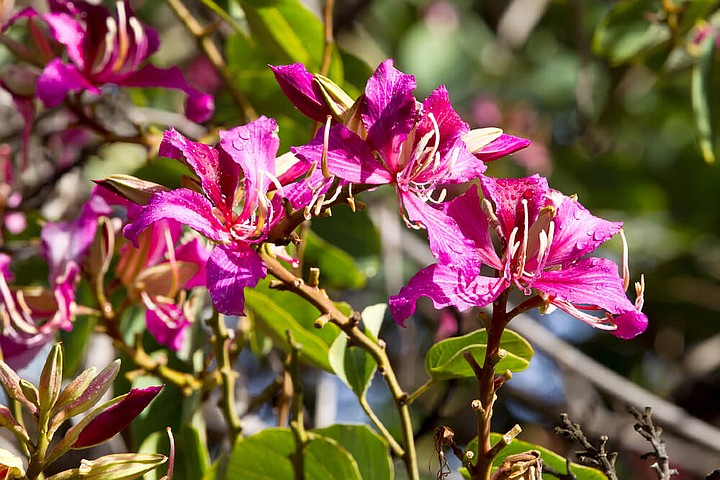 Facebook
Facebook
 X
X
 Instagram
Instagram
 TikTok
TikTok
 Youtube
Youtube

Vernal Equinox on Sunday, March 20, at 8:32am Pacific Daylight Time heralds the beginning of the spring season for Earth’s northern hemisphere. At the instant of vernal equinox, the sun lies in the plane of Earth’s equator. As a consequence, days and nights are of equal length (12 hours each) everywhere on our planet. Another consequence is that the sun rises due east along the horizon and sets due west. During the next three months, as the sun shines more and more directly on our hemisphere, daylight hours will lengthen and the rise and set positions of the sun will gradually shift toward the northeast and northwest, respectively.
India Hawthorn, one of the most common flowering shrubs used in landscaping as hedges and dividers in San Diego, is blooming best right about now. The plant, which has several varieties, covers itself with blossoms ranging in hue from pinkish white to vivid pink.

Orchid Trees, now at their flamboyant best in front yards and public spaces throughout the city, are showing off their large, orchidlike flowers in shades of pink, purple and maroon. Orchid trees thrive in areas with a mild winter climate, hence their popularity in Hawaii, southern California, and Arizona.
Last-Quarter Moon on Thursday, March 24. The Moon rises as late as around 3 am local time, depending on your location. It’s in or near the Teapot of Sagittarius. Catch the Moon and the Teapot higher in the south-southeast just before the beginning of dawn: about 1½ to 1¾ hours before sunrise. By then the Teapot is resting level. It’s about the size of your fist at arm’s length.
The above comes from the Outdoors listings in the Reader compiled by Jerry Schad, author of Afoot & Afield in San Diego County. Schad died in 2011. Planet information from SkyandTelescope.org.


Vernal Equinox on Sunday, March 20, at 8:32am Pacific Daylight Time heralds the beginning of the spring season for Earth’s northern hemisphere. At the instant of vernal equinox, the sun lies in the plane of Earth’s equator. As a consequence, days and nights are of equal length (12 hours each) everywhere on our planet. Another consequence is that the sun rises due east along the horizon and sets due west. During the next three months, as the sun shines more and more directly on our hemisphere, daylight hours will lengthen and the rise and set positions of the sun will gradually shift toward the northeast and northwest, respectively.
India Hawthorn, one of the most common flowering shrubs used in landscaping as hedges and dividers in San Diego, is blooming best right about now. The plant, which has several varieties, covers itself with blossoms ranging in hue from pinkish white to vivid pink.

Orchid Trees, now at their flamboyant best in front yards and public spaces throughout the city, are showing off their large, orchidlike flowers in shades of pink, purple and maroon. Orchid trees thrive in areas with a mild winter climate, hence their popularity in Hawaii, southern California, and Arizona.
Last-Quarter Moon on Thursday, March 24. The Moon rises as late as around 3 am local time, depending on your location. It’s in or near the Teapot of Sagittarius. Catch the Moon and the Teapot higher in the south-southeast just before the beginning of dawn: about 1½ to 1¾ hours before sunrise. By then the Teapot is resting level. It’s about the size of your fist at arm’s length.
The above comes from the Outdoors listings in the Reader compiled by Jerry Schad, author of Afoot & Afield in San Diego County. Schad died in 2011. Planet information from SkyandTelescope.org.
Comments